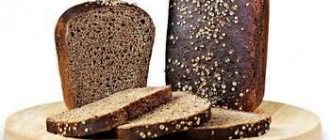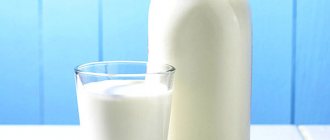The benefits of kefir
Kefir is a source of phosphorus, necessary for rapid recovery.
In addition, it is a storehouse of antioxidants that neutralize the negative effects of free radicals on muscle fibers. Calcium normalizes hormonal levels and strengthens bones. But to ensure that all nutrients and calcium in particular are absorbed to the maximum, choose higher-fat kefir. On the other hand, low-fat kefir fights bad cholesterol and prevents the formation of plaques.
What else is kefir rich in? Its chemical composition includes choline, beta-carotene, potassium, copper, chromium, sulfur and sodium. The drink literally “rejuvenates” the body: cleanses the blood, normalizes the acid balance and microflora of the gastrointestinal tract, and strengthens the immune system.
Kefir is also one of the few dairy products that people with partial lactose intolerance can drink. Milk sugar in its composition turns into lactic acid, which is absorbed much better and does not cause allergic reactions.
Composition and calorie content of kefir of different fat contents
The chemical composition of kefir is as follows: macroelements important for the body: potassium (5.8%), calcium (12%), magnesium (3.5%), sodium (3.8%), sulfur (3%), phosphorus (11 .3%), chlorine (4.3%).
Vitamins in kefir: H, PP, D, thiamine (B1), riboflavin (B2), niacin (B3), choline (B4), pyridoxine (B6), cobalamin (B12). Folic acid (B9), ascorbic acid (C).
As well as a complex of trace elements: aluminum (0.3%), iron (0.6%), iodine (6%), manganese (0.3%), copper (1.2%), molybdenum (7.1%) , zinc (3.3%), and in minimal quantities strontium, fluorine, chromium, selenium.
Kefir contains useful saturated, monounsaturated, polyunsaturated fatty acids, sterols, Omega-3 and Omega-6. The calorie content of a kefir drink is on average 41 kcal per 100 g: including proteins 3.6 g, carbohydrates 3.6 g, ethyl alcohol 0.03 g, water 90.4 g, ash 0.7 g. Kefir has calorie and fat content depends on the original product. How many kcal per 100 g of kefir?
- in 1% - 34 kcal per 100 g;
- in 2.5% - 53 kcal per 100 g;
- in 3.2% - 60 kcal per 100 g.
The acidity (ph) of kefir drink is 85-120 °T, the alcohol content is 0.6%.
Kefir in sports
Don’t be surprised, but kefir has the right to compete with sports nutrition. The fact is that this fermented milk product is not just rich in protein. It is rich in protein, which digests slowly, prolonging the feeling of fullness. In addition, this protein - casein - is very important for muscle growth. It maintains protein levels between meals.
You can drink kefir immediately after training to combat hunger and help your muscles recover faster. In addition, kefir can be used as a substitute for dinner. Kefir at night will strengthen the immune system and heart muscle. In addition, it suppresses the proliferation of pathogenic microorganisms in the intestines. And these processes, as you know, start exactly after sunset.
But before playing sports, especially before cardio exercise, it is better not to drink a fermented milk drink, so as not to experience possible discomfort in the stomach. Gurgling noise will be distracting and interfere with your workout.
Summarize
Until now, most studies on the effects of kefir on the human body show positive effects. One study found that this fermented milk drink has strong antimicrobial, anti-inflammatory, antioxidant, and antitumor properties (29).
Research has shown that kefir may also help improve digestive health in a variety of ways, including directly inhibiting pathogens and increasing the production of beneficial bacteria. Consuming this product may even be effective in treating ulcers (30).
Kefir
Kefir: diets and fasting days
Since kefir is a healthy and dietary product, it is often used to lose extra pounds.
Entire diets are built on the basis of kefir or fasting days are arranged. We have collected the most popular options for losing weight using kefir. But first, let us remind you that all of them will not be suitable if you are: - a pregnant woman or a nursing mother;
- hypertensive;
- diabetic;
— preparing for surgery;
- have heart, kidney or gastrointestinal disease;
- You train often and a lot.
How to choose and store kefir
It is best to choose kefir that is as fresh as possible, with a short shelf life, produced in your region. It is believed that on the third day the beneficial microorganisms in kefir die and it becomes useless. But yeast fungi still continue to multiply in it - they eat sugar and produce alcohol and gas - this can cause a bottle of kefir, left for several hours at room temperature, to inflate. And in the heat it could even explode!
Therefore, kefir can only be stored in the refrigerator . We drink it for three days and then add it to the dough for pancakes and pancakes.
Kefir-buckwheat diet
The diet lasts a week. The expected result is minus 5 kilograms. The advantage of this diet is that you hardly have to cook. All you need is to stock up on kefir with a fat content of no more than 1% and boil or steam the buckwheat. As you can see, everything is quite easy to do and on a budget.
If this diet seems too meager to you, you can diversify it with dried fruits, honey, vegetable oil and natural yogurt. Just without fanaticism.
As part of this diet, kefir can be drunk half an hour before or half an hour after meals. And also pour buckwheat into it. In addition, it is recommended to drink enough plain water and not eat food later than 4 hours before bedtime.
How to make kefir?
Real kefir contains only milk (can be a mixture of whole, skim and dry) and a starter made from kefir grains. Kefir can be made at home by adding a few tablespoons of store-bought kefir to pasteurized or boiled milk (it will be ready within a day). If you become the happy owner of a kefir grain starter, then a small amount of it can turn milk into kefir in 3-4 days (3 tablespoons per 1 liter). Then the kefir needs to be strained, and the fungi can be reused. When the kefir grain is "resting" and not eating milk, it must be washed every day, otherwise it will get sick.
Kefir is rarely subjected to heat treatment. However, you can prepare some dishes with it: for example, season it with salad, muesli or okroshka. Kefir is also used to ferment dough, in particular, pancake dough.
How to make kefir
Add kefir starter (5–6% volume) to pasteurized milk and mix. Ferment for 10–12 hours at temperatures above +20C until a dense clot forms. The mixture produces lactic acid, alcohol and carbon dioxide.
Then the contents are continuously stirred, cooled to +12..+16C, left for 4-6 hours for biochemical maturation - the development of yeast, acetic acid and aroma-forming bacteria.
Afterwards, the contents are cooled to 8-10C and left for another 12-24 hours for physical and chemical maturation - saturation of the kefir curd with carbon dioxide, changes in protein substances, increasing the water-binding capacity of casein, reducing free moisture, and acquiring the strength of the curd.
The action of yeast causes swelling of the protein, accumulation of alcohol and carbon dioxide. The drink acquires a characteristic aroma and taste.
At the end of ripening, the finished product is cooled to +2..+4C.
What is kefir
This is a fermented milk drink. No one knows exactly where it came from, but many consider the Caucasus Mountains to be its homeland. Scientists suggest that the word kefir itself comes from the Turkish “keif”, which means “good feeling”.
This drink itself is unique; it is the only dairy culture that is formed using the so-called kefir grains. Kefir grains are gelatin particles held together. These grains contain a mixture of bacteria and yeast along with milk protein and complex sugars. They ferment milk, introducing their beneficial microorganisms to produce a fermented milk product. The sour taste of kefir is given by lactic acid, which is formed during the fermentation of lactose found in milk by the bacteria Lactobacillus Caucasus.
- 171
More details - 603
More details
- 630
More details
- 315 234
More details
Kefir contains not only the good probiotic bacteria found in yogurt, but also beneficial yeast. It is this symbiosis of yeast and bacteria that allows kefir to be one step higher than yogurt, surpassing the latter in terms of “healthiness”.
Also, kefir, unlike yogurt, is cultivated at room temperature. Kefir can be obtained not only from cow's milk, but also from goat's, sheep's and even coconut or almond milk.
Benefits for weight loss
Kefir is often used in diet menus. After all, this is a natural product, full of useful substances, which also helps normalize digestion and remove excess fluid and toxins.
To achieve a tangible result, you can arrange a fasting day using a fermented milk drink. It should be drunk for breakfast, lunch and dinner, replacing main meals. It is also possible to combine the product with various fresh fruits and berries. Kefir is able to give the body a feeling of satiety and provide it with essential vitamins.
Attention! Although this method is effective, I do not recommend that you use it more than once a week.
Kefir diet with black bread
Using black bread, rich in fiber, allows you to quickly cleanse the body and remove harmful substances from it. In addition, this product is rich in carbohydrates and can give you more energy. On such a diet you can lose up to seven kilograms per week.
On the day it is recommended to consume:
- 500 grams of black bread;
- 1 liter of kefir (I recommend choosing a 1 percent drink);
- 2 liters of water;
- green tea.
It is better to eat bread during breakfast and lunch, and drink the bulk of kefir at night. Tea and water can be drunk at any time without special restrictions.
How to choose the right kefir?
If you look closely at the table of the chemical composition of kefir, you will see an interesting thing: the content of vitamins and macroelements in a product with different fat content is almost identical. “So why eat extra empty calories if the benefits are the same?” - the loser will exclaim. And... he will be wrong.
A difference of 38 kcal per 1 glass of fermented milk drink will not make a difference. But calcium and protein from low-fat foods are absorbed much worse. Therefore, if 3.2% fat is too scary, make a reasonable compromise: buy kefir with a fat content of 2.5%.
The pursuit of low-fat dairy products very quickly leads to an increase in insulin in the blood. This entails metabolic failure, hormonal imbalances and... rapid weight gain.
Why should you ferment homemade kefir?
Store-bought kefir is often not fully fermented. And pasteurization, which all store-bought dairy products undergo, kills not only harmful but also beneficial bacteria.
Homemade preserves all the beneficial properties, and you can independently control the process of obtaining it. All you need for this is kefir grains. This drink, made from live kefir grains, contains 35 different types of beneficial bacteria and yeast.
The process is extremely simple and natural:
1.
Take glassware. It is very important not to let kefir grains come into contact with metal - it kills them. Plastic is also not recommended for use.
2.
Place grains in a jar, fill with milk, cover with a paper towel or gauze.
3.
We forget for a day or two.
4.
After this, we strain our homemade kefir. Without washing the grains (chlorinated water also destroys kefir grains, so be careful if you decide to wash them), put them in a clean bowl and fill them with milk. And again we enjoy our kefir.
The beauty of homemade kefir is that the grains can be said to last forever.
All kefir grains need is regular feeding: put them in milk, leave them at room temperature for one day, and they will feed you kefir in return.
Feed them every day. Once the kefir has become thick, it is ready: it usually takes a day to ferment: during this time it acquires the best taste. Afterwards, the grain can be removed and used to prepare a new batch. If fermentation continues for too long, the drink may become too sour and harsh, and may separate into whey and curds. If kefir is left at room temperature for more than a week and the grains are not fed, it can ferment and the grains die.
If you want to take a break from making kefir, the grains can be placed in the refrigerator, where they will be stored without requiring care for several months. Simply place them in a jar of fresh milk, close the lid tightly, and place them in the refrigerator. In this way, the culture can be preserved for up to three months.
When you decide to make kefir again, remove the grains from the jar, place them in milk and leave at room temperature.
The grains will be dormant, the fermentation of the first batch of kefir will be slow, and it may not turn out the way it should.
Kefir grains can be dried: in this state they can be stored for months, or even years.
When you decide to make kefir, place the dried grains in milk. And again, the first batch of kefir may not turn out exactly as it should, but all the subsequent ones will be simply great.
Do not use 2% or skim milk to make kefir. Firstly, fermentation will be very slow, and secondly, all products with chemically reduced fat are harmful to our body. So, prepare it from full-fledged milk, or even better from fresh, unpasteurized milk.











